We’ve been preparing the answer to this question for 4 years – long and hard 4 years bootstrap of startup with huge ambitions.
In this article we’ll try to frankly share with you all the difficulties of the past stages of our work, the problems and dilemmas that we faced, and, eventually describe the solution model, which we were so scrupulously heading to, that now we can afford writing articles with such titles.
We should state that as such, we never had the goal of becoming a billion-dollar corporation at the very beginning. But when we first considered the answer to this question while studying the YC application form for filing 3 years ago, we realized that the essence is not even to become a billion-dollar corporation, but to have that as a vector. It helps to focus and it’s sobering in many ways when you have it as a reference. As it sobered us after studying the application. To which stage will we continue to grow and how will the external investments in specific details, not in general terms, help us to solve the difficulties that we had foreseen at that moment.
And all these doubts became the result of the attempt to answer the question: How will we become a billion-dollar company?
Therefore, we decided that at that moment we were not ready, and until we ourselves could not give an answer to this question and get an understanding of how we plan to solve the difficulties facing us in a concrete way, then applying for an accelerator or raising investments can be very risky.
We have therefore postponed these opportunities until we have addressed all these painful issues. Our following 3-year path started like that by collecting the puzzle step-by-step to be able to answer the question of the title of our article.
But before I go to the narrative with the answer to it, I need to immerse you in the history and the difficulties that we’ve been working on all this time and found solutions.
So, make yourself comfortable, as the article will be quite long, but filled with insights and revelations, which, I am sure, can eventually be useful to many.

How it all started
We began our journey at the junction of 2 hype currents.
4 years ago there was an active hype around chat bots. Many called them new drivers of the technological revolution, a new era that has come to replace social networks and they predicted a great future for this course. Slack was actively developing with its ecosystem of bots and integrations. It was the fastest growing startup in history at that time.
Accordingly, these factors jump-started the fact that we decided to start a business in Slack through some kind of use case covered by a chat bot. We weren’t the 1st ones to enter this market. We did it at least a year later than our competitors. Anyway, both me and my co-founder Alex were already quite experienced in terms of building startups, which allowed us to lay down several basic things from the very beginning, which subsequently predetermined our victory over all the rest who came to this market before us with a similar use case.
Firstly, we immediately understood that the number of useful use cases for chat bots is very limited. We didn’t really believe in all this hype around them. But we were sure that some things could be done more efficiently with the help of chat bots mechanics.
But the understanding that the number of use cases is very limited and somehow everything comes down to the form factor of surveys, we could foresee that in a very short period of time there will be many identical products that will do exactly the same thing. And in а longer time lag, many of those will also be equal in quality.
Therefore, we knew that it was necessary to enter the market, starting with a narrow use case, which would initially be a part of a big idea, that we would systematically pump from small to large in the end. Consequently, we have entered the market with the positioning of a digital assistant right away, which should serve many processes in the future, where we chose Standup meetings as the original driver. We also knew for sure, that after some years we would have to grow not at the account of Standups, but by means of complex of more difficult processes, which we could computerize for companies.
This insight greatly predetermined the strategy for the design of our product.
We immediately focused on the unified architecture, both technically and in the UX plan for the development and coverage of many different use cases, not just stand-ups.
Secondly, we realized that the growth of Slack cannot be infinite. MS Teams was not even on the horizon yet, but we knew for sure that someone else would enter this market, and just like us, those who come to Slack with delay will take or capture most part of the market anyway.
As we all know, it did happen.
But this insight also greatly affected the development strategy of our product from the very beginning.
We deliberately gave full priority to the development of universal solutions, so that when the second big player appeared, we could adapt the entire functionality of our product for it in a short period of time.
We didn’t waste our time on the tight integration of exclusively Slack dependent nice-to-have features, аs we knew that in case another player appeared, it would most likely not have all the same small fеаtures that Slack provided, or they would work and be integrated in another way, which, in its turn could lead to the fact that we would simply have to make a separate product in technical terms for a new platform.
It got at some of our competitors, who had to implement a stand alone solution to the same idea but for a new platform, when MS Teams out from the shadow.
We did not want that to happen, and instead, we focused on increasing the universal stock associated with the automatization of more complex processes for development teams and companies.
Thirdly, we were sure that our growth should eventually be associated with large enterprise corporations, so the product design should be more adapted to them for a large number of teams within one huge company to be able to use the product more conveniently.
Fourth, even after the release and start of the growth of MS Teams, the player we expected and foresaw, we were in no hurry to immediately go into it.
Many of our colleagues told us that we have a validated use case that brings money and that we need to expand the market as quickly as possible by entering a new platform, while everything is still generating there.
But we had a different opinion. Analyzing the business situation and understanding our key problems, we assessed joining MS Teams only as a postponement of the moment when we would still face the challenges that we already understand now. This was like raising the ceiling strips, which we had to bump up against in the future, but not in any way by means of expanding the market.
We believed that it was impossible to ignore it. First we had to solve the difficulties we processed from the of work on one platform, in order to come to the second one with a settled solution.
Otherwise, we could fall into a trap, when we quickly entering a new platform, we bury ourselves in solving tactical issues, whether it be bugs, small add-ons and adapting to the platform, rather than solving fundamental issues for which we do not have enough resources.
Moreover, the following factors played into our hands:
- Preparedness of product design and architecture to scale to a new platform at any time and in a short time.
- A large number of bugs in MS Teams in the first few years of its existence. We understood that in such an ecosystem a competitor that conquers the entire market will not be able to develop, so we just watched, solving fundamental issues.
And finally, fifthly, we were very cautious about the growth of the first years, which we had and were not deceived by its results. Our experience has told us that growth is tested exclusively by time. And the key point in it is your paid user’s LT.
Therefore, the growth of the first year does not mean anything until you understand what LT your product has. And you can only understand this in an experimental way.
Therefore, we simply carefully monitored all the metrics of our product like doctors, so that we could understand what processes take place in the body of our product and which laws they comply with.
We knew for sure that until we fully understand this, we should not, as in races, turn on nitrous oxide ahead of time in the form of investment acceleration.
And we figured it out. But as a result, we got a number of fundamental issues and difficulties that we had to solve.
What did we encounter?
Limited LT.
The first, and perhaps the most important thing that we’ve found out is that the use case of asynchronous chat bot processes has limited LT. This is no longer due to the inefficiency of such a decision, although there is a certain churn due to the fact that teams begin desiring to return to normal live communications over time.
But we could influence the factor of this churn in a certain way, which we did by adding to the product the ability to respond to reports using video or voice. We automatized live team calls when, in an asynchronous text version, our product collected team members’ responses to the same stand-ups, as an agenda, for the upcoming call, and at the scheduled time for the call sent the entire team a link to the video conference, which is also implemented inside our product, so that the team can already simply go through the completed agenda with answers and be focused only on discussing problems.
But the main reason of limited LT is related to teams and projects disbanding, especially within the large corporations we associated our growth with.
The teams themselves have a limited life cycle.
Firstly, there are not so many successful product teams in the world that with the same team, as we do, for example, have been making the same product for 4 years.
Startups appear and burn.

And secondly, teams in large corporations are constantly reorganized, as they have a huge number of projects with a large turnover of personnel.
What’s interesting is that if we get a first-category team from among successful startups to customers, then at some point, due to its success, it goes into the category of a large company, where the processes of personnel turnover and many different projects are launched.
And this in turn leads to the fact that the new team may no longer inherit the pattern of using our product, and the old team just no longer exists.
And it seems logical, but only when you got to the bottom of it. Initially, we did not see this.
ARPA.
The second is the average check. There are also 2 components here:
1. You can either grow by the average check per user, which is very difficult to do while being inside another product platform, Slack or MS Teams, which have their price ceilings per user. And the limitation of useful use cases within the framework of this platform is very small in order to take more money from the user than the platform itself takes for it.
2. Or you should grow through cumulative effect and scale, which in its turn is very difficult due to the LT issues described above.
As a result, we had to find some non-standard solution.
Users acquisition.
The third is the market volume and acquisition options for new users.
We quickly realized that the market volume of Slack and MS Teams, regardless of their rapid growth, is not equal to our market volume.
We were at the bottom of their market funnel.
First of all, not all the users of these corporate messengers use chat bots. This trend is still emerging.
I am talking precisely about full-fledged chat bot mechanics, which implies communication with a digital assistant. We know absolutely for sure that successful products like ours, especially in terms of financial metrics, in the stores of these two platforms are limited.
And if you open the rating of all applications in the same Slack line, you will see that 90% of the leading positions in it are occupied by integrations of popular services and only the remaining 10% are products built on top of the platform.
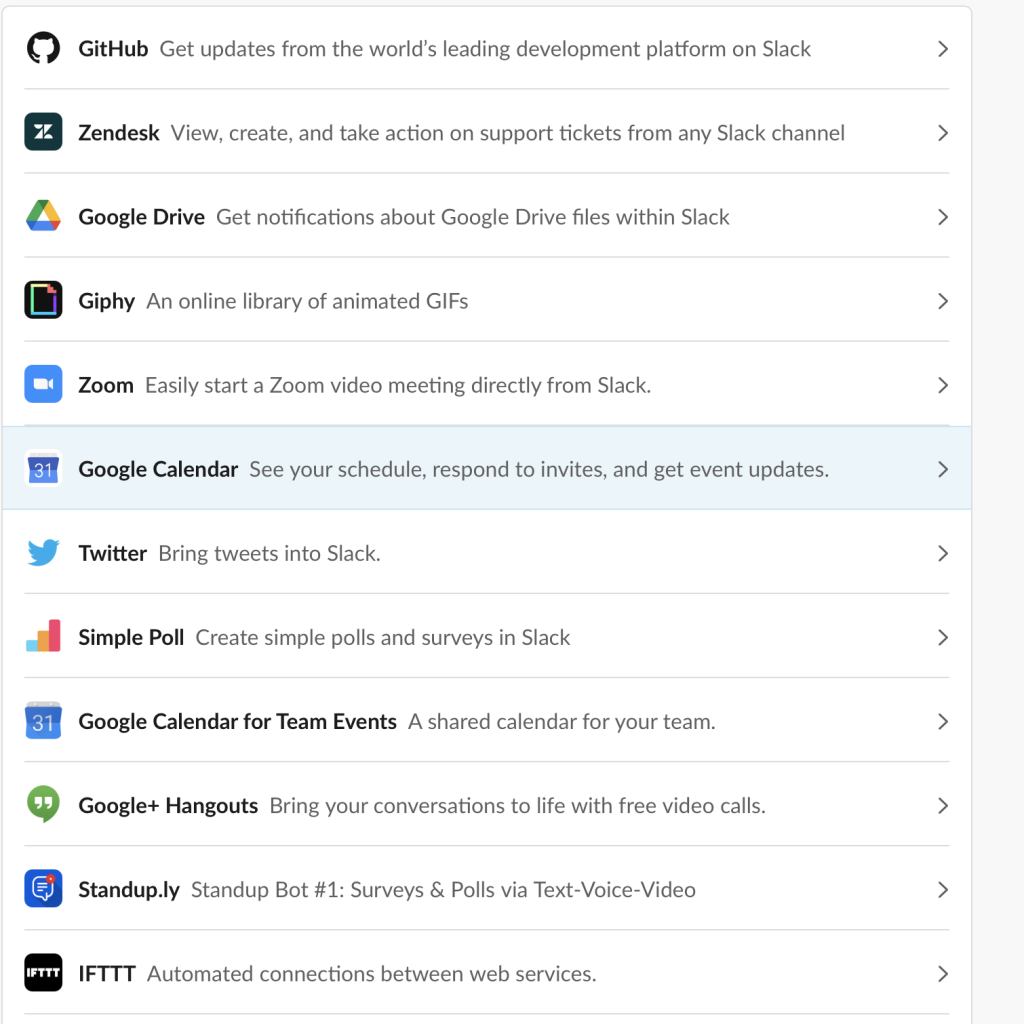
Standuply is in the TOP-10 of all apps in the store, and TOP-1 product in this rating, which was built precisely on chat-bot use case. We are more popular than many large stand alone service integrations, but are on the general list among the minority, albeit successful on top of the platform solutions.
Secondly, our funnel is still narrowing from those who have come to the pattern of using chat bots to those who need exactly the solutions that we offer.
What gives a very limited tool to attract new traffic. You must narrow down to requests, such as Slack standup bot or Run planning poker in Slack, whose funnel is small.
We worked on the issue of market size for a particularly long time, before we reached the decision.
So, we smoothly got to the main part of my article, in which I will describe the answer to the question in the title of this article.
Yes, yes, all the above-mentioned was only a preface.

What will turn us into a billion dollars company?
Product.
Success, of course, always has many components. But when we talk about such big goals, of course, they mainly depend on the idea of the product that you do.
Recently, we have put in our picture the last element of the puzzle, which completed the formation of the concept of our product, which we are ready to scale now and which is built to solve all the difficulties that I wrote about earlier and on which we have been working for a long 3 years.
Read more about the latest release here.
The detailed structure of current product is described in our Mind map. Let’s go through each part.
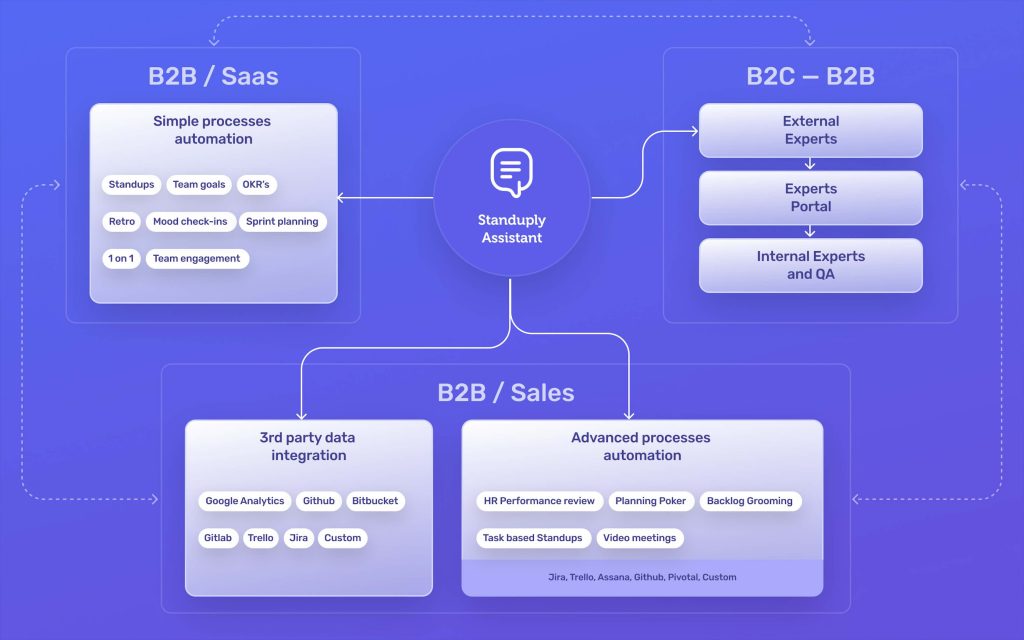
Our product conceptually consists of 3 interconnected verticals. I will call them as we name them in our company.
Part I. Standuply Automation (B2B SaaS).
This is part of our product, which currently serves as the main driver for attracting users. I.e. this is the Standuply integration itself for Slack and MS Teams, which is installed by our users through search in the application stores of these platforms, by simple keys as standup meetings, retrospectives, polls, team mood, etc.
This is the part of the product that was born from that narrow use case from which we started and which is completely self-service.
Teams choose the product for simple and well-known processes and begin to automate them using our solutions, deploying to a team or teams within the company.
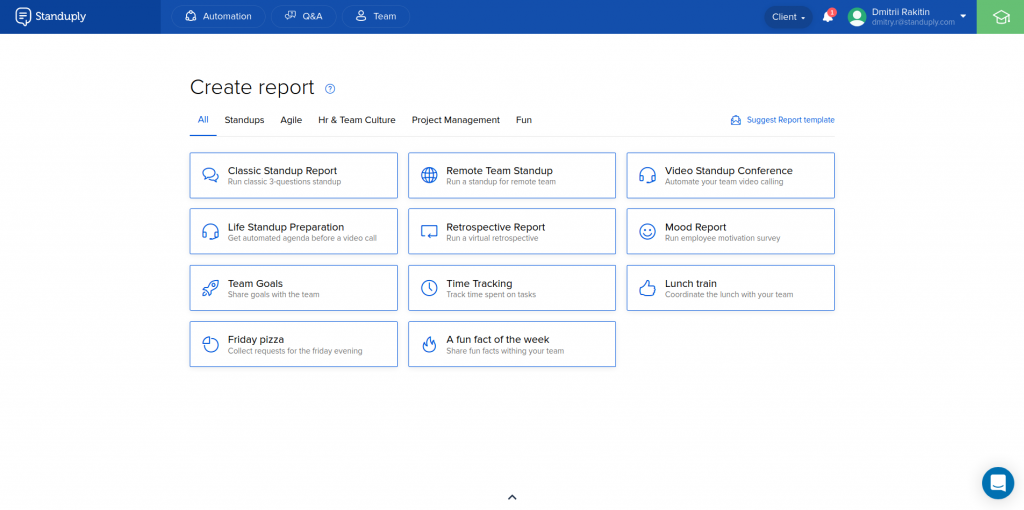
Part II. Standuply Automation (B2B Sales).
This part of the product is already focused on larger teams and is promoted through sales and close interaction with customers.
We help to adopt the product, connecting it to more and more processes of the company, helping to build it into the features of software development that every customer has.
This is the part where we help to integrate our product with user systems such as task trackers, databases, Git systems and more.
This allows to cover not only basic processes based on flow surveys, but also to create a comprehensive project management assistance system, through the automation of more complex rituals that require integration with user systems. This includes backlog grooming, planning poker, sprint planning, 360 degree surveys, OKR, Onboarding process, etc.
In addition, the presence of the ability to automate most of the software development processes in the product allows us to join teams where these processes do not exist yet, And to sell them, not even the automation itself, but the processes that will help the company become more efficient and Agile. Everything is in the best traditions of JTBD.
And, of course, the more processes are deployed within the team, the more LT becomes of the use of our product.
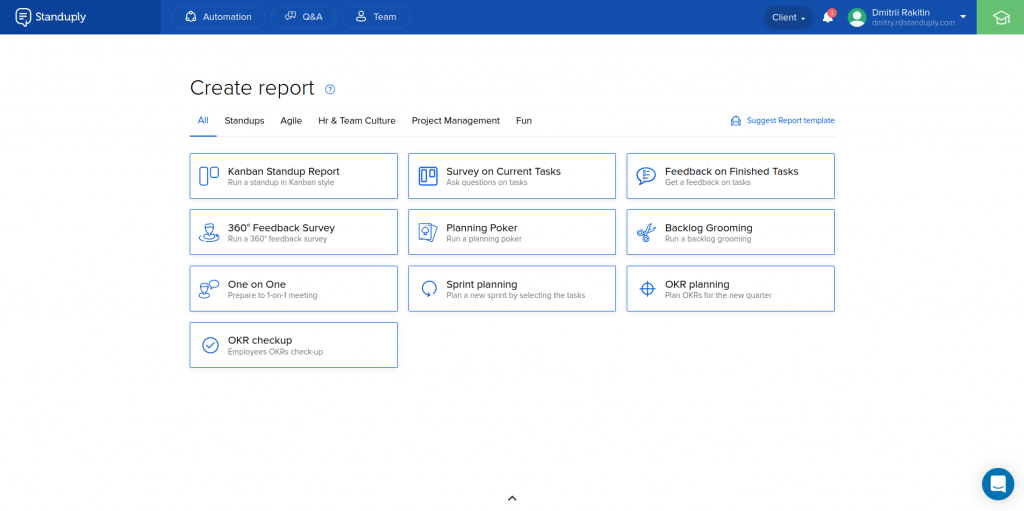
Part III. Standuply Q&A (B2C-B2B).
This part, completed just recently, finished the concept of the product as a digital assistant, which not only automates company’s processes, but which any employee in the company can turn to with any professional question and Standuply will give an answer. It consists of 2 parts, as the name implies:
B2C. It has the goal of expanding our market by attracting users to the product on a multiple of the funnel. We engage on an individual use case those, who have any professional questions related to various topics in IT. There is no need to connect it to Slack or MS teams to use.
There is just an ocean of users who want to receive any answer or professional advice. But we also know that among this ocean there are those who will remain in the product in future having learned about the number of processes that we automate, and who already use business messengers or will start using them in the company in the near future, but will already be familiar with us. So, we are greatly expanding out funnel, which was originally built around narrower team use cases.
And the same Standuply users who use it in large and successful companies and are ready to share their experience and knowledge with other colleagues become experts in the product. This triggers a unique synergy, where 80% of users from smaller companies can seek advice from 20% of the world’s best companies.
In addition, we are conducting a separate attraction of experts from outside the Standuply users to our platform. And this activity has a very large response from professionals who are ready to share their knowledge with others. And these experts, who are kind of influencers in their companies, cities and even regions, subsequently become ambassadors of our product for their audience when they get acquainted with our automation module. And in the context of our Affiliate Program, which is written about the “Business Model” section, this activity is aimed at a huge result.
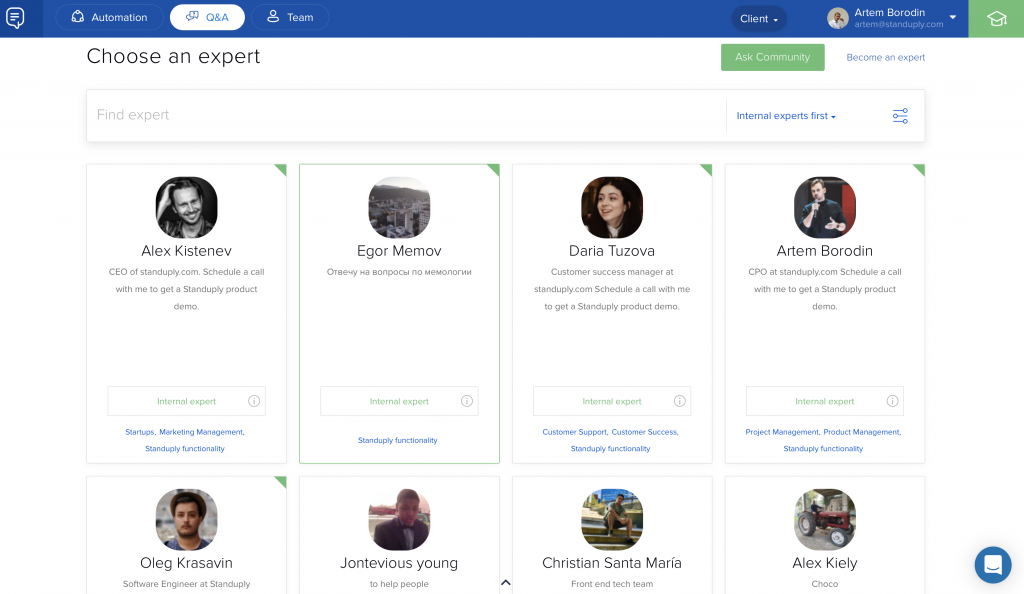
B2B. This part forms the Q&A system of the company and should subsequently become the main driver for increasing the average check. Standuply users generate a lot of data on their projects and company. Often, a lot of information is repetitive for internal employees of the same organization. Standuply Q&A allows you to store this data, along with training materials or consultations from third-party experts, forming a company’s knowledge base with the ability of any employee to access the stored information.
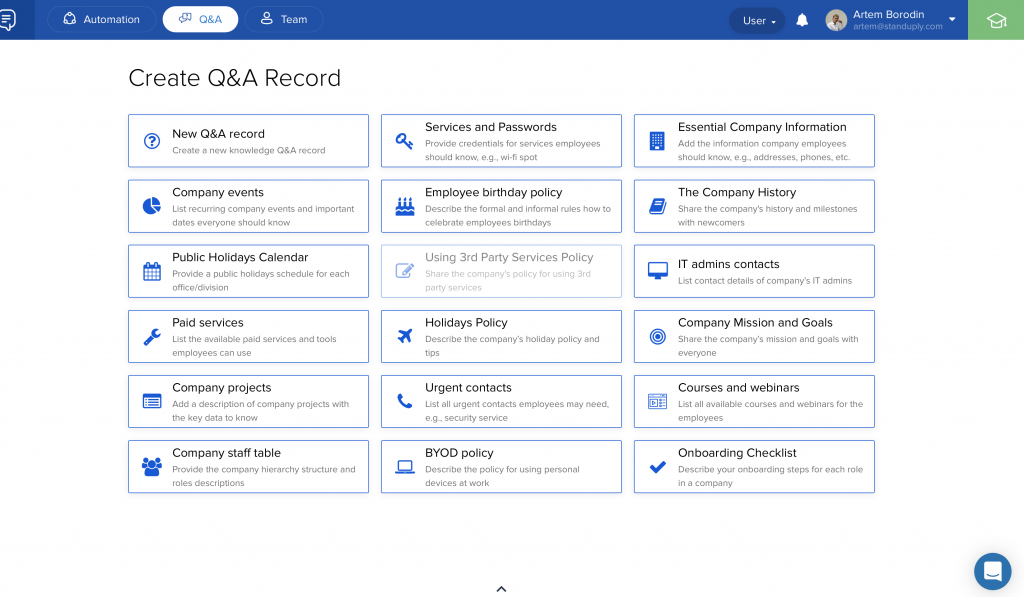
You no longer need to look for who in the company owns this or that information. Standuply creates a form-factor, you just need to write him a question in the company’s messenger, without disturbing anyone else. If, at the request, Standuply finds information previously saved with it, it will instantly issue a knowledge unit for the request, or direct a person to the right expert inside or outside the company, selecting candidates who are most likely to be able to answer the user.
And for such a use case in the product, including a very long LT, because the more information is accumulated in standuply, the more valuable it becomes for the company every day, we can already take money at the level of the cost of subscriptions of the corporate messengers themselves.
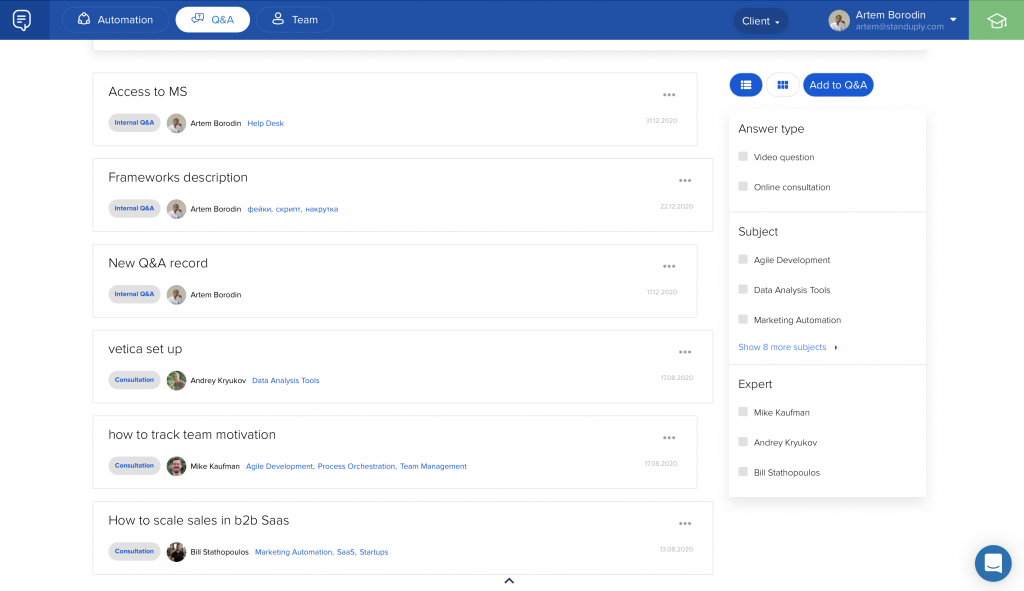
All these parts of the product are strongly interconnected and work for one goal, within the framework of one concept, but solving separate problems and overcoming all the difficulties that we faced together.
2. Business model.
It is equally important, in addition to the product itself, to have the right business model for it.
As I wrote earlier, we initially planned growth at the expense of large companies.
But we had to overcome the difficulty of constantly disbanding teams within large corporations and reassembling them for new projects in different compositions.
With these difficultyies it was very problematic for us to grow inside each of the companies.
It took more resources to attract new teams within one organization due to the natural churn within the same organization. In the end, we basically just stayed on the same level. The number of newly recruited teams to one degree or another corresponded to the number of those who left, due to their re-sorting.
The growth model from a small number of paying respondents to covering the entire company did not work.
But, at one point, an inspiration came to us. We figured out how to turn around to our advantage whatever we viewed as a problem.
We realized that our basic automation use cases should not be built around a pay-per-user model in the Enterprise segment.
We figured out how to turn our weakness into our strengths and launched Enterprise plans at a low base price for an unlimited number of respondents.
Their goal was not to try to increase the LT of product use by a separate team, but to increase the LT subscription of the entire company, due to the fact that for little money in large organizations, a set of different teams is constantly formed within the product, with their natural life cycle, which can use Standuply by default without any restrictions.
We sell Enterprise subscriptions at a price higher than individual teams can afford, but practically free in the context of their use by a large corporation for any number of employees.
So within the company’s subscription, there is a constant change of different teams using standuply, but the subscription itself lives indefinitely, which allows us to launch a cumulative effect of retaining old users for a long time, increasing LT to the level of the most famous B2B products, and attracting new customers.
But why am I writing about this so openly, not fearing that competitors may go the same way, having similar problems?
Everything is simple here, the fact is that this growth model is impossible if you do not have some part of the product due to which you can continue to grow within your client. Because selling at a fixed price to a large customer implies a ceiling on the growth of your average check within that customer.
Such models are risky if you do not work them through consciously and thoroughly.
Because in the case of subsequent investments, investors will not see how you will ultimately ensure your constant growth dynamics.
But we have such part of the product and this is Standuply Q&A.
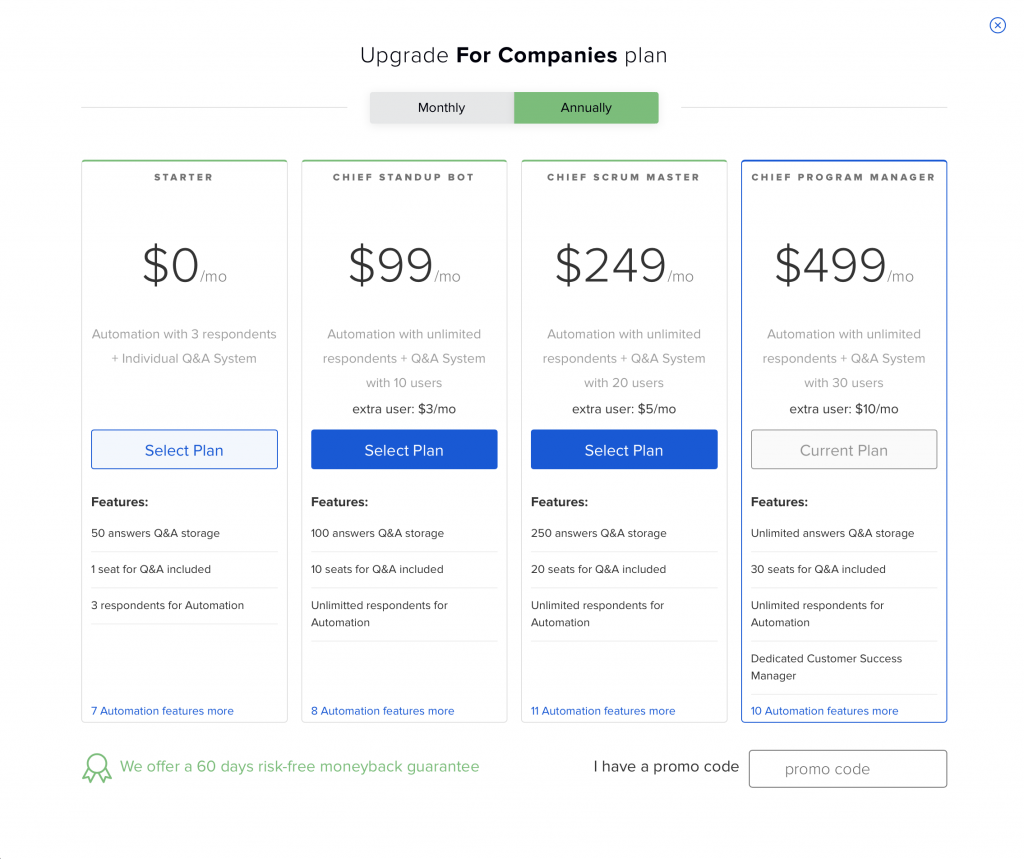
That is why we have worked out the issue of the business model and product layout very thoroughly, so that in the end we can give our basic, popular use case for inexpensive, and for large corporations practically for nothing, so that it becomes one of the drivers of our distribution, which will quickly disperse the product for large corporations in which we will later get our own for the infinitely valuable Q&A use case.
And we speak openly about this because we have already formed and tested everything, and competitors will still come to this idea, but they will have a long and painful road of product transformation in search of such an additional module as Q&A in our country.
Because we have been shaping the product according to our ideology from the very first day, and they have to rebuild it, which is an incredibly painful process and will take a lot of time, which we, in turn, will spend on polishing everything that we have and increasing the share we occupy in the market.
Besides, having a complex product for automating processes in a company for completely different teams, one of the key places in our growth model is planned to be given to our emerging partner program. As part of this program, we invite organizations and individuals around the world that are working on the implementation of Agile approaches and practices in the company to become our ambassadors. And if in the course of their work, they can organically integrate our solution into the company to automate some part of the processes that they implement in the company, then according to the rev-share model, these ambassador companies will receive a constant percentage of the use of Standuply in the company, in which they brought in.
3. Team.
And, of course, nothing is possible without people.
Our company has a product-centric focus. Where everything is built around the product team.
Everything that I described above, we made with a team of only 9 people.

Everything that we have done, we do not give to anyone, but check and implement everything on our own.
For example, my co-founder Alex and I, with our own hands, launched and checked absolutely all processes in order to understand every detail and be sure that we chose the right process and it can be scaled by attracting other people.
Until we figured out the process ourselves, no matter how new or unpleasant they were for us, we never gave them to anyone.
Everything that is done in the product is worked out or designed by me, from the interface to the texts.
Everything that is done in marketing is tested or debugged by Alex.
We ourselves figured out and launched customer support, customer success, sales, HR, security assessments and much more. We ourselves figured out and went through everything related to incorporation, reporting, taxes.
We had both the resources and the ability to outsource all this, but this is not in our nature.
At one time, I came from a large corporation to engage in startups, with a large baggage of knowledge, but with a clear understanding that I want to do real things, with a full understanding of all the mechanics, and not engage in imitation of product activities, reporting on invented KPIs.
Common sense, hard work and focus are what drives our entire company.
This atmosphere fills every employee, who, first of all, is not just an executing unit in the product team, but a person who has the own zones and is responsible for their development.
We are not shy to say that our main metric is financial success.
We know how to focus and not do anything unnecessary.
We value and recruit specialists who not only think, but also do.
Our main framework is rapid prototyping and subsequent tracking of metrics, continuous improvement of the product and processes, prioritization based on feedback and analytical data following the launch of the prototype, which ultimately allows us to find the right vectors of development.
And according to these principles, we plan to scale our team as well. And if we were able to do so much with 9 people, then what will we achieve in
our scaled structure for the product that we have now.
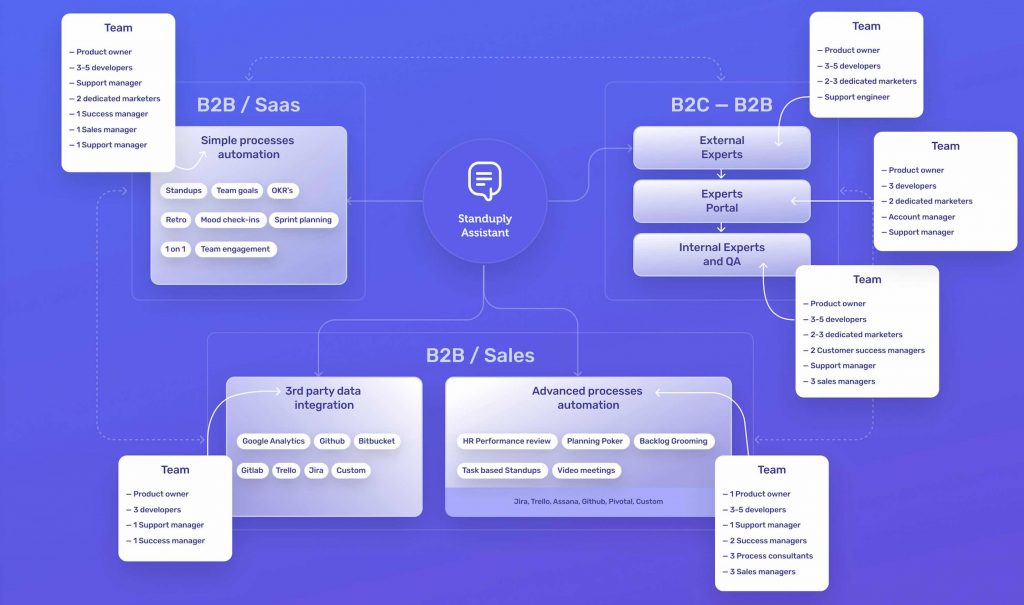
4. Market and its vector.
Another very important point that should be attributed to the factors which we rely on is the development trend of our market.
As once, 4 years ago, we were at the junction of several hype currents, which became one of the keys to our current results, and now we are moving along the way to four intersecting and upward trends at once, the effect of which enhances both each other and our other benefits I described above.
Industry vector.
The software development industry is actively moving towards the automation of most of the processes that until recently performed separate roles in the team.
Actually, once my observation formed the basis of our concept.
Being a project and product manager for more than 10 years, having certifications from PMI and the Scrum Alliance, reading my own courses on project, product and team management, at one point I clearly realized the imbalance between the methodologies and frameworks used and the changed operating world to which they have not had time to adapt yet.
When many of the Agile frameworks were taking shape, it was for the reason and issues of the environment at the time. When more flexible principles were to replace cascade development, solving the problem of speed, quality, necessity and competitiveness of the developed software products.
This is how Agile, Scrum and other Agile ambassadors appeared.
But 20 years have passed since their appearance, and they themselves, in their essence, have hardly changed. But the world around has changed. And 4 years ago I knew for sure that it couldn’t be like that and methodologies should not work in the same way as they were prescribed 15 years ago if environment has been changed.
Over this long time, Agile approaches have been absorbed with mother’s milk by a generation of new professionals and developers.
From the need for evangelism, we smoothly flowed into the need to automate routine processes.
When the values of processes do not need to be conveyed to people, you can facilitate only their formal implementation.
The value of many professions, including the Scrum Master or Project manager, began to change, often due to the fact that the team members themselves could already independently control and follow the processes for which the roles of the former were once formed.
Add to this the development of technologies that have made it possible to work efficiently, flexibly and remotely. None of this existed 20 years ago, and I felt that we were on the same threshold of transforming work processes as we once did in the 2000s. Then, our product could not exist, but now it is harder to exist without it.
And this trend is only accelerating.
Remote work trend.
It is not even worth describing the situation in particular, everything is crystal clear anyway.
The development of technologies gives new opportunities and formats for the work of a modern specialist.
Against this background, as in claim 1, the environment forms its requirements for established methodologies that were not possible before.
The world after the pandemic.
Everyone understands that world will not be the same.
It will definitely not be completely remote, as people have realized that bends in any direction, whether it is completely office work or completely remote, have many disadvantages. But it will become more flexible and hybrid.
The pandemic and the forced 100% teleworking of all people in our industry will accelerate the development of a more hybrid work environment. When office and remote work will be mixed. The best of both formats will be combined.
People felt that if they were able to work at least a few days from home, or elsewhere, they could draw more energy and strength, which could be directed towards the work itself or personal balance, due to the savings in time and costs of travel and much more.
But they also felt that in a situation where everyone is remote, for a long time, there is a strong drawdown in productivity due to the deterioration in the quality of live communications.
Therefore, the uniqueness of the situation for us is no longer even in the fact that for a certain period of time everyone became remote, as we made a product for remote teams from the very beginning, but in the fact that in the world after the pandemic, when everything is over, the value of our product will be times higher than even now, because, to solve the real problem of a mixed environment, when on different days and at different times, different team members are partly at the office, partly at home, in the absence of such obvious pressure as it is now, from the lack of live communications, in these conditions precisely such automated solutions as our product is needed..
Digital assistants have become part of our consume life.
Not yet complete, but progress in this area is evident. If five years ago people used virtual assistants in their phones more as fun, today we can say with confidence that the basic form-factor of their use for real tasks in our consumer reality has already been formed.
The development of technologies in the field of AI, IoT, machine learning, neural networks, made it possible to conveniently use virtual assistants for simple everyday tasks.
I was recently very amazed how my eldest daughter does almost all of her homework in most subjects in the 3rd grade with the help of her assistant. Moreover, it answered her qualitatively to questions that even I could not quickly answer without googling.
For us and our product, this is another vector indicating that virtual assistants will soon enter our professional reality just as tightly. There will be a whole line of highly focused ‘Siri for work‘ in different areas, where Standuply, we believe, will be in the forefront.
Afterword.
We have set ourselves the immediate goal of 10M ARR. This is a serious step and a big challenge, but if we have coped with it before, then why not now? We have already passed so many milestones, we thought.
The main thing we believe is that if you know what you want to reach, follow the metrics and painstakingly, step by step, solve one difficulty after another, then in the end you may not be a billion-dollar, but definitely you will become a successful company.


